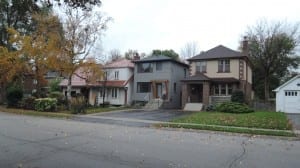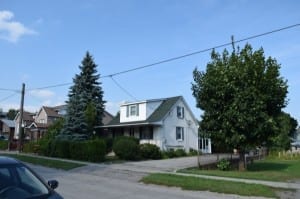I have observed and photographed many roofs
Every one in a while I borrow a library copy of a Pattern Language (1977) by Christopher Alexander.
Pattern 117 is described as the “Sheltering Roof”
On p. 570 of my copy of the book, two photographs are laid out side by side. The caption reads: “One roof lived in, the other stuck on.”

The two houses on the right represent a situation where a roof is added to the top of an existing structure, without enclosing the living quarters that it is associated with. Jaan Pill photo
“The roof itself only shelters if it contains, embraces, covers, surrounds the process of living. This means very simply, that the roof must not only be large and visible, but it must also include living quarters within its volume, not only underneath it.”
Different people will look at roofs each in their own way
I agree with the text’s assertion regarding roofs. I especially like the sight of a large pitched roof with a dormer or dormers.
One of the key variables, as I see it, involves the amount of thought that has gone into the three dimensional design of a roof structure. If the roof structure has been thought out well, from the perspective of the psychological impact from the street and from within the building, then that is a source of satisfaction.
Metaphorically speaking, when I roof that is beautifully designed according to its function as the integral feature of the living space that it serves to protect and enclose, what I see is not just a roof but the concept that underlies the final product.
What applies to a well designed roof, one that attends to everyday human needs and desires, applies to many other well designed products, including conceptual products, whatever form they may take, in my view.
What is the cost? How do we measure value?
If the roof – literally or figuratively – is simply stuck on top of an existing structure, without further thought, then the available space in the structure is maximized, and design and construction costs are kept down. But the question is: At what cost?
It’s not a question of which kind of roof is better than another. Every roof has its place, and is the product of particular circumstances, including the available resources, of whatever kind. There’s no reason that every roof should meet some narrow range of specified criteria, and life is arranged in such a way that we encounter a wide diversity of roofs, wherever in the world we may travel.


Leave a Reply
Want to join the discussion?Feel free to contribute!